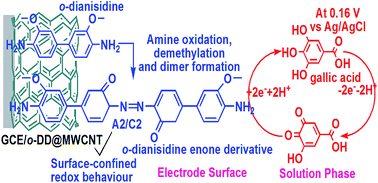A new electro-generated o-dianisidine derivative stabilized MWCNT-modified GCE for low potential gallic acid detection†
Abstract
The exploration of functional group interactions and electro-generated species stabilization on chemically modified electrodes for efficient electro-analytical application is a continuing research area in electrochemistry. In addition, the electrochemical behaviours of the intermediate species, which are generated from the aromatic organic redox mediator and possess both methoxy and amine functional groups, have been rarely studied for electro-analytical applications. For the first time, we report the stabilization of an electro-generated enone derivative of the o-dianisidine (EDo-D) dimer formed as one of the intermediate species during o-dianisidine immobilization. The electro-generated o-dianisidine derivative (o-DD)-stabilized multi-walled carbon nanotube (MWCNT)-modified glassy carbon electrode (GCE/o-DD@MWCNT) exhibited two highly reproducible and, well-defined surface-confined redox couples in a pH 7 phosphate buffer solution (PBS). FTIR analyses indicated the presence of an amine group linkage and an azo product in the o-DD@MWCNT hybrid. UV-Vis and GC-MS analyses confirmed the presence of o-dianisidine in its azo dimer form within the MWCNT. In addition, the enone derivative of the o-dianisidine dimer present on the GCE/o-DD@MWCNT successfully sensed gallic acid (GA) at 0.16 V vs. Ag/AgCl in pH 7 PBS. Highly selective GA detection was achieved with a sensitivity of 0.4580 μA μM−1, a detection range of 100–1300 μM and a detection limit of 144 nM using chronoamperometry. GCE/o-DD@MWCNT also demonstrated effective GA detection in simulated real grape juice and water samples.


 Please wait while we load your content...
Please wait while we load your content...